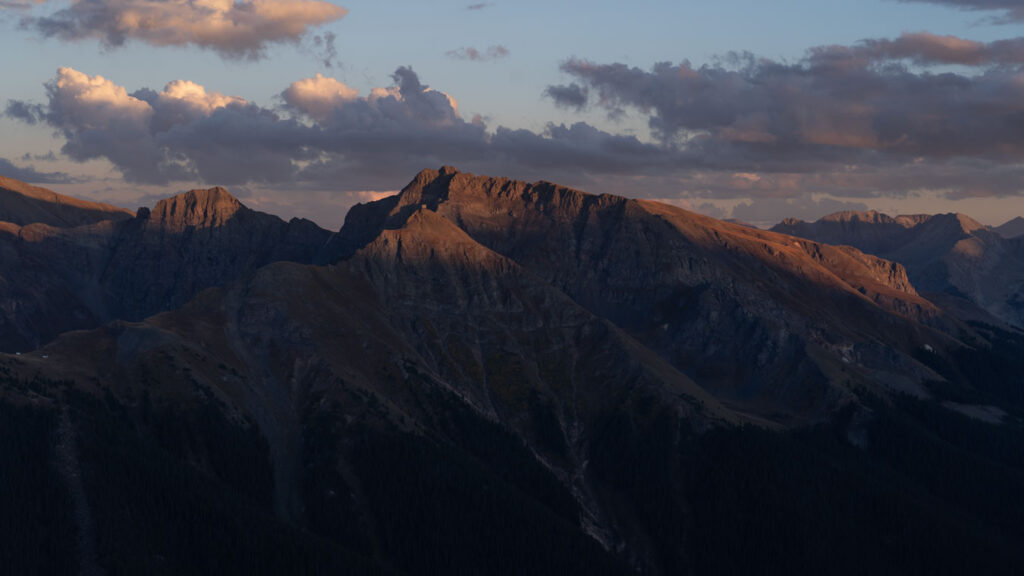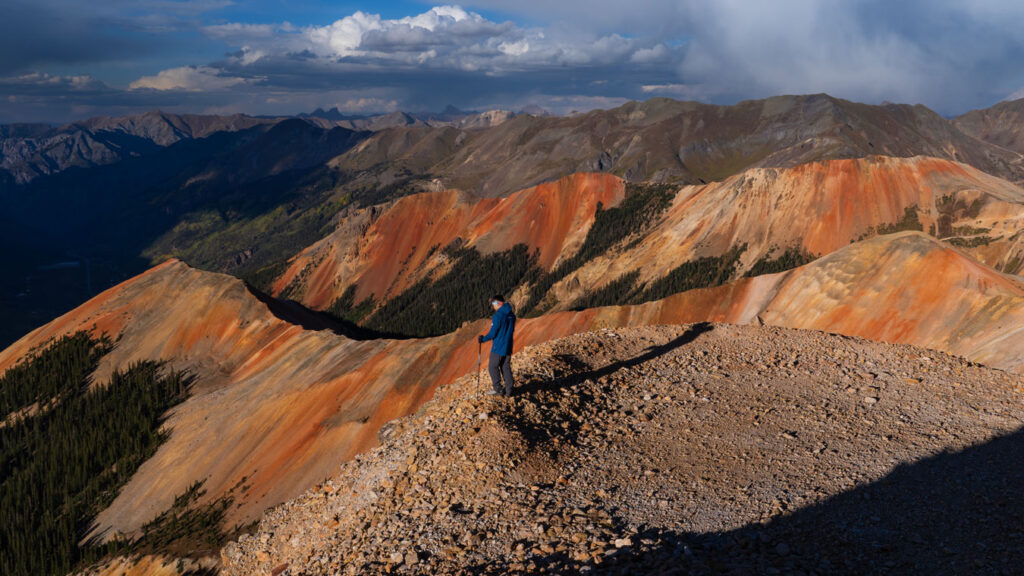Colorado’s Red Mountain #3, also known as Rainbow Mountain, is one of the most visually striking peaks in the San Juan Mountain Range. Its distinctive red, yellow, and orange hues make it a photographer’s dream, and yet, this peak is far less crowded than other iconic Colorado hikes. If you’re looking for a challenging yet rewarding day hike that combines vibrant scenery and a peaceful summit, this adventure to Rainbow Mountain might just be for you.
Overview of Red Mountain #3 famously known as the Rainbow Mountain
Red Mountain #3 is part of the Red Mountain Range, known for its rich deposits of iron oxide, which give the mountains their trademark rusty red color. The area has a deep mining history, with remnants of old mines visible along the hike, adding a touch of history to the natural beauty. The mountain’s colors are especially vivid during the summer and fall months, when the contrast of wildflowers or golden aspens enhances the experience.
How to Find the Red Mountain #3 Trailhead and Parking Options
The trailhead for Red Mountain #3 is conveniently nestled between Ouray and Silverton, just off the iconic Million Dollar Highway (US 550). From Ouray, it’s about a 30-minute drive, while Silverton is only 20 minutes away. If you’re using AllTrails, it will direct you to a trailhead (37.89584, -107.71371) located on the southbound side of Hwy 550, directly across from the Black Bear Pass trailhead. Here, you’ll find a small parking area, though spaces are limited—especially during the busy summer months. Arriving early is key if you want to secure a spot.
After further research, I discovered that many hikers opt to park near the gate (37.89079, -107.70739) leading up to Red Mountain Three Road or at the nearby St. Paul Lodge and Hut (37.88993, -107.70755), as I did. This option shaves off about 1.4 miles from your round-trip hike, compared to starting at the highway parking lot. However, if you plan to drive past the original trailhead, be sure to bring a 4WD vehicle with medium to high clearance, as the road is quite rugged and uneven.
What to Expect on the Trail
The trail to Red Mountain #3 is mostly a well-trodden path. However, the higher in elevation one gets, the trail has its share of rocky outcrops, and loose scree, making for a moderately challenging hike. The round trip distance from the highway parking lot is approximately 5.5-6 miles, with an elevation gain of around 1,800 feet, so be prepared for some steep sections as you near the summit. Along the way, you’ll pass through alpine meadows and get glimpses of the surrounding peaks. The final stretch to the summit can be tough, but the panoramic views from the top make every step worth it.
Views of the distant mountain peaks once in the alpine zone.
The magnificent peaks of the San Juan Mountain range. Views on the hike up to the peak of Red Mountain #3.
Looking back at the trail traveled from near the summit.
The well-defined trail on the final switchback.
The final stretch before reaching the summit of Red Mountain #3.
What I didn’t realize until I reached the summit (37.90157, -107.68910) was that the adventure doesn’t have to end there. You can actually continue hiking along the ridges of the surrounding peaks, which offers the opportunity to extend the hike significantly. Every step beyond the summit adds to the out-and-back distance, making it a choice for those with extra time and stamina. I started my hike in the early afternoon, aiming to catch the sunset over the vibrant rainbow-colored peaks. While I managed to do just that, knowing what I know now, I wish I had started earlier. The ridges beyond the summit would have provided even more incredible vantage points for photography, and capturing that light over multiple peaks would’ve been stunning. If I could do it again, I’d definitely plan for extra time to explore the ridges beyond.
Hiking the ridge of one of the Rainbow Mountains.
Recommended Gear and Preparation:
Given the rugged terrain and unpredictable weather in Colorado’s high country, it’s crucial to come prepared. Make sure you’re wearing sturdy hiking boots with good ankle support, as the trail can get rocky, especially near the summit. Trekking poles are highly recommended, as loose scree becomes more plentiful the closer you get to the summit. Layering is essential, as temperatures can drop quickly at higher elevations. Don’t forget to bring plenty of water, sun protection, and a map or GPS device, as cell service can be spotty. Also, be aware that afternoon thunderstorms are common in the summer, so plan to start early and finish before the weather turns.
Capturing the Best Photos on Red Mountain #3: Photography Tips
As you make your way up the trail, be sure to keep your camera within reach, as the ascent offers some stunning photo opportunities. While the iconic Rainbow Mountains don’t come into full view until you approach the summit, the climb provides breathtaking panoramas of the western, southern, and eastern peaks of the San Juan range. Once you reach the summit, you’re treated to the incredible sight of the vibrant red, orange, and yellow hues of the mountains, especially if you time your hike for early morning or late afternoon when the golden light enhances the colors. That along with a 360 degree panorama of the vast mountain landscape below. However, I found that the most striking photos came from continuing beyond the summit along the ridges, where the expansive views and dramatic angles made for some truly unforgettable shots.
Taking in the views of the vibrant colored mountains.
Some of the 360 degree views seen from the summit.
The last sunlight of the day touching the distant peaks seen from the summit.
Wildlife and Flora: What You Might Encounter
The San Juan Mountains are home to a variety of wildlife, and if you’re lucky, you might spot marmots or mountain goats along the trail. In the summer, the alpine meadows around Red Mountain #3 come alive with wildflowers, adding pops of color to the already vibrant landscape. Remember to keep your distance from any animals you encounter and stick to marked trails to protect the delicate flora.
Staying Safe: Precautions for Hiking Red Mountain #3 at High Altitude
Hiking at high altitude, such as on Red Mountain #3, requires extra care and attention. As you ascend, the air becomes thinner, making it harder for your body to absorb oxygen. This can lead to altitude sickness, which presents with symptoms like headaches, nausea, dizziness, and shortness of breath. One other common sign of the effects of altitude is the increased frequency and urge to urinate. This is a symptom related to the body’s efforts to adjust to the lower oxygen levels. As someone who lives at sea level, I felt I had to urinate every tenth of a mile or so, on the ascent of this hike despite spending several days in 7000-9500’ of elevation prior to doing this hike. So it’s essential to pace yourself and stay hydrated throughout the hike. Carry plenty of water and drink regularly, even if you don’t feel thirsty. I personally brought 3L of water for this hike and drank every bit of it by the end.
While I am not a medical doctor, it’s important to watch out for signs of more severe altitude sickness, such as confusion, loss of coordination, or persistent shortness of breath, as these could require you to descend immediately. It’s a good idea to take frequent breaks, allowing your body to acclimate as you climb. If you’re feeling unwell, don’t push yourself—descend to a lower elevation and take time to recover.
Sunset over Red Mountain #3 – The Rainbow Mountain.
In addition, high-altitude hikes often come with unpredictable weather, so be prepared for sudden temperature drops or storms. Pack warm layers, even if the weather seems favorable at the start. As a general rule, start early to avoid afternoon thunderstorms, which are more common in mountainous areas. Being aware of both physical signs and weather changes is key to staying safe during your high-altitude adventure. In the event of a thunderstorm, there is little to no cover once past the alpine zone so plan accordingly, and watch the surrounding weather signs.
Nearby Attractions: Exploring More of the San Juan Mountains
After completing the Red Mountain #3 hike, you may want to explore other nearby attractions. The historic mining town of Ouray, known as the “Switzerland of America,” offers hot springs to relax your sore muscles. For more hiking, the Ice Lakes Basin Trail near Silverton is a stunning option, taking you past alpine lakes that shine in brilliant blue and turquoise. And if you’re into scenic drives, the Million Dollar Highway is one of the most beautiful and thrilling roads in the country.
Conclusion: Why Red Mountain #3 Should Be on Your Hiking List
Red Mountain #3 may not be the most famous peak in Colorado, but its vibrant colors, challenging terrain, and sweeping views make it a must-see for any adventurous hiker. Whether you’re a seasoned pro or a casual hiker, this trail offers something for everyone. Add this stunning mountain to your Colorado hiking bucket list and experience the lesser-known beauty of the San Juan Mountains.
Have you had the chance to photograph Colorado’s San Juan Mountains? Share your experiences in the comments below! If you’re planning a trip and have any questions about hiking and photography, feel free to ask. For more photography tips and guides, follow me on Instagram and Youtube to stay updated on my latest adventures.
















